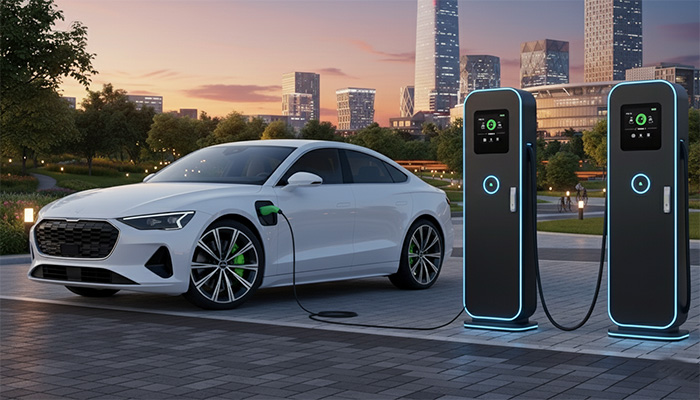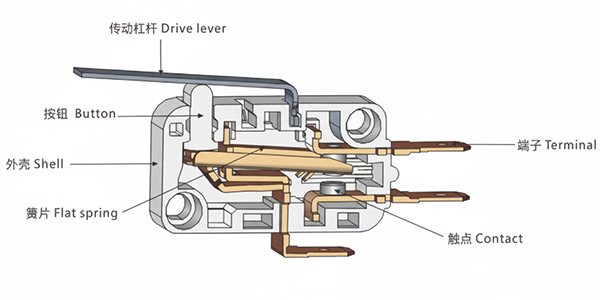With the rapid development of the global Electric Vehicle (EV) industry, the safety and reliability of EV charging infrastructure have become core elements for ensuring user experience and sector health. As the critical physical interface connecting the electric vehicle to the high-voltage energy network, the internal design of the EV charging connector must meet extremely stringent safety standards. In this context, the Micro Switch, or Snap-Action Switch, with its unique rapid action and high-precision characteristics, serves as an indispensable precision component within the charging gun, primarily executing high-voltage safety interlock and charging sequence control. Through precise mechanical operation, it not only ensures the correct initiation and termination of the EV charging process but also physically constructs a robust line of defense against major safety hazards such as arc damage and overheating due to poor contact. This critical function underscores the necessity of choosing a reputable micro switch manufacturer. It is the fundamental safeguard for achieving safe, efficient, and reliable charging.

Core Functions of Micro Switches: Safety Interlock and Timing Control
The micro switch’s function in the EV charging connector is to establish the first physical line of defense for the high-voltage safety circuit, primarily reflected in precise control over the charging sequence and real-time monitoring of the connection status.
1.1 Power-Off Protection and Physical Signal Transmission
The micro switch’s operating mechanism is intimately linked to the handshake sequence of the charging protocol, assuming core responsibility for initiating and terminating charging.
-
Charging Initiation Interlock Signal: When the user fully inserts the EV charging connector into the vehicle’s charging inlet, the micro switch contacts are physically engaged, sending an “engaged/fully connected” level signal to the Charging Management System (CMS). The system only permits subsequent charging communication after receiving this signal, ensuring a safe start.
-
High-Voltage Disconnection Sequence: The physical placement of the micro switch is crucial. It must be the contact point that breaks first within the charging gun. The moment the user begins to withdraw the connector, the micro switch’s contacts are released instantly, immediately instructing the charging pile to cut the power output of the main high-voltage circuit. This “signal-before-power” disconnection sequence is the key mechanism for preventing arcing and high-voltage short circuits caused by plugging or unplugging the connector while it is still energized.
Related reading: Microswitch Application in Safety Interlocking of New Energy System
1.2 Real-Time Physical Monitoring of Connection Status (Anti-False Insertion)
The micro switch, through its mechanical structure, provides hard verification of connection reliability in EV charging.
-
Eliminating False Insertion Risk: The micro switch requires the charging gun to reach a predetermined depth and position to trigger the switch action. This effectively prevents “false insertion” scenarios, which can lead to poor contact between the connector and vehicle pins, increased contact resistance, and resulting localized overheating risks.
-
Locking Status Auxiliary Judgment: In some EV charging connectors equipped with electronic locking features, the micro switch is also used to help monitor whether the mechanical or electronic locking mechanism is reliably in place. High-voltage charging can only proceed upon locking confirmation, further enhancing the stability of the charging process.
Advanced Advantages of Micro Switches: Electrical Stability and System Integration
The micro switch is not only an executor of safety functions; its intrinsic electrical characteristics and durability are core advantages that enhance the reliability of the entire EV charging system.
2.1 Electrical Guarantee: Snap-Action and High Reliability
The Snap-Action structure employed by the snap action micro switch is its core advantage regarding electrical assurance.
-
Instantaneous Contact Switching: Regardless of how quickly or slowly the user operates the charging gun, the internal contacts of the micro switch complete the opening and closing switchover at a constant, extremely high speed. This effectively prevents contact bounce near the switching threshold, fundamentally reducing the generation of arcs and sparks between contacts, and ensuring the stability of current transmission.
-
Precise Control of Current Flow: The precise action ensures that charging start and stop commands are transmitted in milliseconds, preventing system instability due to electrical signal delays or misjudgment, and greatly improving charging process reliability.


Related reading: How Micro Switch Contact Materials Affect Performance
2.2 Safety Protection: Durability in Harsh Environments
The EV charging gun is a device constantly exposed to external elements, and the micro switch must possess resilience commensurate with the environment.
-
High Protection Rating Requirements: Micro switches typically need high specifications for dust and water resistance (IP ratings) to cope with outdoor challenges like rain, snow, and dust intrusion, ensuring they can still provide accurate and safe interlock signals in harsh environments.
-
High Mechanical Life: Given the high frequency of charging gun insertion and extraction, especially in public charging stations, the micro switch must possess an ultra-long mechanical life to ensure long-term operational stability and low maintenance costs.
2.3 Foundation for Operation Convenience and System Integration
A reliable micro switch is the cornerstone for realizing advanced EV charging system features.
-
Enhancing Automation: The stable physical feedback provided by the micro switch allows the charging pile and the vehicle to automatically adjust the charging mode based on the connection status, optimizing the overall charging automation process and delivering a smooth and convenient plug-and-play user experience.
-
Seamless Integration with Smart Control: As a crucial link in the underlying hardware sensing, the micro switch’s interlock signal can achieve seamless and reliable integration with core control systems like the Charging Management System (CMS) and Vehicle Control System (VCS), providing the most accurate initial data input for the system to achieve higher-level intelligent functions like overload protection and smart scheduled charging.
Related reading: Understanding Micro Switches on Disconnectors
Conclusion
In summary, the micro switch is an irreplaceable physical safety core and electrical assurance foundation in Electric Vehicle (EV) charging connectors.
It utilizes its unique mechanical interlock design and the “signal-before-power” timing control logic to physically reinforce the first hardware defense line against major safety risks such as energized unplugging, contact arcing, and overheating from poor contact. Simultaneously, the micro switch’s Snap-Action characteristic ensures the instantaneous switching and extremely high reliability of the high-voltage circuit’s ON/OFF signal, effectively avoiding electrical interference caused by contact bounce—a key factor supporting the stable transmission of high-power, high-current flow. This stable and precise physical feedback further integrates seamlessly as essential input data for the EV charging management system, providing the most accurate and reliable input for enabling charging automation, fault pre-warning, and even complex intelligent regulation in the future.
Undoubtedly, the performance of the micro switch directly determines the user experience and the intrinsic safety level of charging facilities. Looking ahead, as electric vehicles rapidly move towards higher voltage architectures and ultra-fast charging, and as new charging technologies become prevalent, the industry imposes even stricter requirements on the endurance, precision, and reliability of micro switches. To adapt to the trends of lighter-weight and higher power-density charging connector designs, future micro switches must achieve breakthroughs in miniaturization and integration while possessing enhanced environmental resistance. The continuous innovation and upgrade of micro switch technology will be the core driver ensuring the sustained and healthy development of the next generation of high-efficiency, high-safety EV charging infrastructure.

